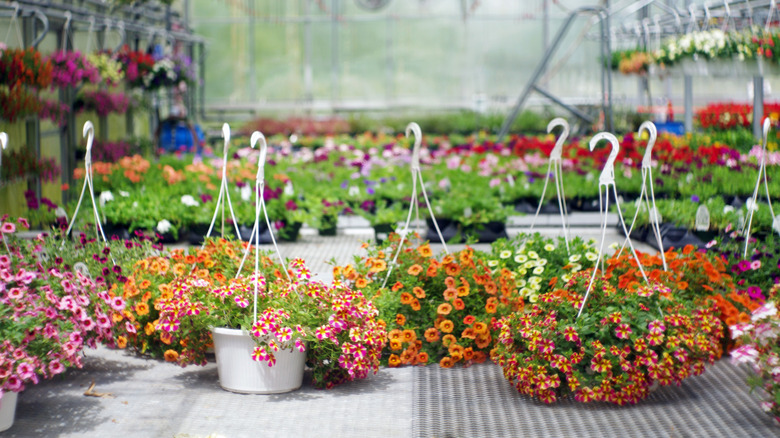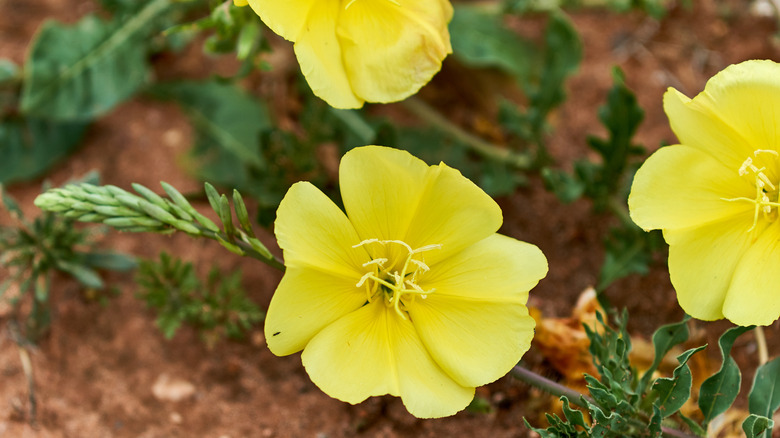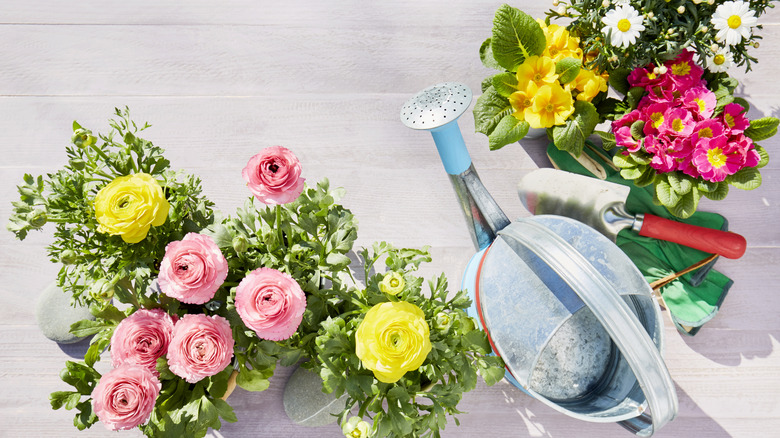Add Butter-Yellow Blooms To Your Hanging Baskets With A Flower That Thrives In Heat
Beautiful blooms in hanging baskets can brighten up your front porch and add depth and variety to any landscape. But when temperatures rise, some flowers will wither away. The intense summer sun can turn lush, vibrant flower baskets into burned, barren eyesores. Luckily some flower varieties can take the heat and survive summers that are getting hotter and hotter.
Texas primrose (Calylophus 'drummondianus') is one hanging basket option that thrives in the heat. This low-maintenance perennial with delicate yellow blooms can withstand hot, dry conditions and poor soil. It can tolerate intense amounts of sunlight and will thrive in USDA zones 8 through 10, making it a perfect match for your summertime hanging garden.
Growing Texas primrose with other flowers in your hanging baskets can come with added benefits. Texas primrose is known to attract important pollinators like bees and butterflies to your garden which can promote biodiversity and provide natural pest control. This vibrant yellow flower can grow harmoniously alongside other heat-tolerant flowers that love bright, warm spots in the garden. If you're searching for an unfussy plant that will add a pop of color and flourish in hot climates, the Texas primrose could be the perfect fit.
Texas primrose can handle harsh conditions
Texas primrose will blossom in the spring and continue to thrive through the heat of the summer. This easy-going flower is drought-tolerant and will grow heartily in direct sunlight with well-drained soil. You can find these flowers growing wild in prairie landscapes in southwestern parts of the United States, which is why it is affectionately named the Texas primrose.
This unique wildflower opens its petals in the evening time, and will remain in bloom until the following day. As the seasons progress and the plant gets older, the petal's hues turn rosy pink and deep orange. When it comes to watering your Texas primrose, less is more. The plant can withstand drier, drought-like growing conditions, but does not like to be overwatered. Too much water or poor soil drainage can inhibit nutrient absorbency and lead to discolored leaves and limp, lifeless petals. These flowers benefit from a bit of neglect, and the soil should be left to dry out completely in between waterings.
The Texas Primrose should get at least six hours of direct sunlight, even during hotter months. The container-like design of hanging baskets provide the perfect growing conditions for the flower since it's easy to achieve good drainage. Clipping the flower's sunny blooms will encourage growth and resilience, allowing it to continue to blossom for months and months.
Planting Texas primrose alongside other flowers in your hanging baskets
Texas primrose can grow harmoniously alongside other flowers in your hanging basket. Their cheery yellow blooms can brighten up your flower gardens and form mutually beneficial relationships with neighboring plants. Texas primrose is a "spiller plant," meaning it can be planted near the edge of the basket so long, flowering vines can eloquently drape over. Since a majority of the plant will hang outside of the basket, you have room to plant fuller and taller flowers in the same space. Tall plants like salvia can comfortably grow next to Texas primrose and add variety and diversity to the hanging basket.
You can also grow herbs next to your Texas primroses. Opt for perennials that require similar climates and growing conditions like sage (Salvia officinalis) or rosemary (Salvia rosmarinus). Herbs can repel common garden pests with natural oils and scents which can help keep companion plants happy and healthy. Other flowers, like dwarf morning glories (Convolvulus tricolor) and cake pop verbenas (Verbena rigida) can tolerate high heat and harsher conditions, making them a great match for Texas primroses.
When choosing to curate the perfect summer flower garden, picking a plant that can stand up to the heat is critical. Texas primroses can make for a perfect companion plant that blossoms and thrives in even the hottest months. Their uplifting yellow blossoms and low maintenance nature can adapt beautifully to your lush landscapes.


